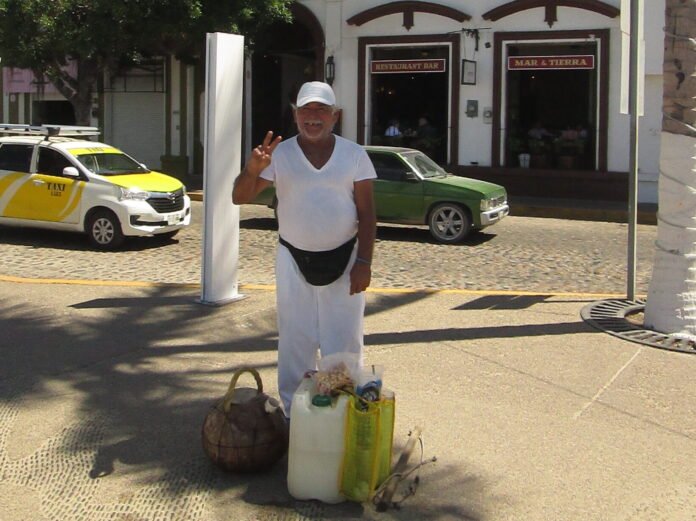By Arlene Pervin
Most people, when they hear the word tuba, think of a huge brass instrument, but I associate the word with a tropical drink and the signature sight of the tuba vendors that station themselves along the Malecon of Puerto Vallarta.
The tuba vendor slings his wares, hung from a three-foot pole that balances across his shoulders.
The large, round, golden-brown gourd hangs from one side, while suspended from the other is a multi-colored nylon mesh bag filled with plastic cups and a plastic baggie filled with chopped pecans and cubes of fresh apple.
He walks the Malecon, the words “tuba, la tuba” tumbling out. I watch him pour the liquid expertly from the gourd that holds the brew, and not a drop is spilled. Then, he adds a few sprinkles of pecan and a few cubes of fresh apple to the cup and hands it to the waiting customer.
Tuba, as it is called in Spanish, is a drink made from the sap of the coconut palm. In Mexico, tuba is mainly linked to the area around Colima, south of Puerto Vallarta. Men, called tuberos, climb the coconut palms to collect the sap twice a day.
A combination of the harvested sap, coconut water, ice, and sugar make up the drink.
A few years ago, I had gone to Los Arcos, the amphitheater in the center of old Vallarta, to watch some entertainment, the dance troupe of folkloric dancers who performed every Friday night.
I had noticed a man slinging a large gourd fitted with an improvised piece of plastic pipe that acted as a spout. It was obvious that Mexican ingenuity had devised a specific use of this gourd-like vessel.
The man walked the rows of the amphitheater, calling out “tubaaa, la tubaaa,” poured the liquid into the plastic cups, and passed it to the waiting customers.
One afternoon, I was toting groceries from the neighborhood supermarket, walking side by side with a man slinging his gourd and wares. I smiled at him and said something like, “muy pesado,” “very heavy,” in acknowledgment of his load.
He turned and said, “quince años,” as he pointed to himself. Fifteen years. I wondered whether his father before him was a tuba seller.
While tuba selling may go back generations, the drink was not native to Mexico. In the 16th century, Spanish galleons that carried spices, silk, and other trade goods also carried this palm species from which tuba was made.
Philippino sailors brought the coconut palm and their knowledge and know-how of making tuba, a popular drink in their native land.
The seeds of cultural crossover between Mexico and the Philippines stem from this time, and the area around Colima proved to be a prime growing area.
Tuba is known in many other parts of the world, including India, Africa, and Southeast Asia. It has many different names: In Nigeria, it is called emu; in southern India, kallu; Sumatra, tuak; and the Philippines and Borneo share their Spanish names, tuba.
In its alcoholic form, for which it is primarily known in other parts of the world, it is called palm wine or toddy. Tuba, in Mexico, is usually consumed as a non-alcoholic drink.
It was a hot and sunny afternoon when I decided to try my first taste of tuba. It is hard to describe the flavor. The taste is a bit like a young fruity wine with a refreshing acidic flavor. It is easy to imagine the fermented form as palm wine.
As I savored the drink, I imagined a Tuba-tasting event with wine glasses lined up and tasters rating each glass for flavor, clarity, sweetness, and bouquet.
One of the tuba vendors I talked to called the gourd a boule. He said if you took care of it, it could last 10 years. I thought about the care to keep a dried squash that long. I would like to know what other uses these large round gourds are used for and where the growing fields are.
Jose Luis, a tuba vendor, told me that every vendor makes his own mix. I’ve never seen a recipe, nor been told the amount or proportions of each ingredient. But like all things passed down from generation to generation, it is not the recipe but a way of life.
The tuba sellers’ “tubaaa, la tubaaa” calls have a higher pitched tone than the orchestral instrument, but their melodic announcement of a drink is as unique as its name. It is just one of the sights, sounds, and tastes that is part of the street music of Puerto Vallarta. Definitely a notable drink.


